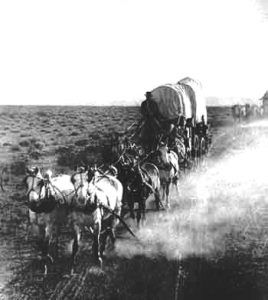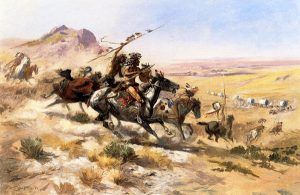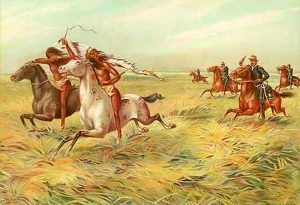By William H. Ryus in 1913
During the coldest time in winter, in January 1863, nine freight wagons left Santa Fe, New Mexico, on their way East. A few miles before they reached the Nine Mile Ridge, they encountered a band of almost famished Cheyenne and Arapaho Indians, who hailed with delight the freight wagons, thinking they could get some coffee and other provisions. In this lonely part of the world, 75 miles from Fort Larned, Kansas, and 175 miles from Fort Lyon, Colorado, without even a settler between, it was uncomfortable to even an Indian to find himself without rations.
The Nine Mile Ridge was a high elevation above the Arkansas River road running close to the river, on top of the ridge.
The Indians followed the wagons several miles, imploring the wagon boss to give them something to eat and drink, which request he steadily refused in no uncertain voice. When the red men knew that the wagon boss was refusing their prayers for subsistence, they knew no other method to enforce division other than to take it from the wagons.
The leader of the band went around to the head of the oxen and demanded them to corral, stop and give them some provision. During the corralling of the train, one wagon tipped partly over and the teamster shot an Indian in his fright. Then the Indians picked up their wounded warrior, placed him on a horse, and left the camp, determined to return and take an Indians’ revenge upon the caravan. The wagon boss went into camp well satisfied — but not long was his satisfaction to last.
After the Indians departed, several teamsters who thought they knew what was desired by the Indians reproached their wagon-boss for not having complied with their request to give them food. His action in refusing food resulted in a mutiny on the part of the teamsters, and after the oxen were turned out to graze, the dispute between the teamsters and the wagon-boss became so turbulent that if a few peaceably inclined drivers had not arraigned themselves on the side of the wagon-boss, he would have been lynched.
Before daylight, the Indians returned and attacked the wagons and killed all the whites but one man who escaped down the bank into the river. He floated down until he was out of hearing of the Indians. When he was almost worn out and half-frozen he got out of the river, wrung the water from his clothing and started for Fort Larned, seventy-five miles distant. After leaving the water he noticed a fire and knew instinctively that the Indians had set fire to their wagons, and wondered how many, if any, of the company had escaped as he had so far done.
Late in the afternoon of the next day, a troop of soldiers discovered this man several miles from Fort Larned in an almost exhausted condition, dropping down and getting up again. The commanding officer sent out some soldiers and brought him to the fort. I talked with this man, and he told me that if the wagon-boss had given the Indians something to eat, entertained them a little, or given them the smallest hospitality, he believed they would all have been saved from that massacre. He said the Indians plead with the wagon-boss for food, and he thought if the teamster had not lost his equanimity and made that first luckless shot, the Nine Mile Ridge massacre would never have become a thing of history.
This tragedy created a great fright and made traveling across the plains difficult. The Indians were hostile only because they did not know the minds of the white men, and what their attitude toward them would be, if they were not always prepared to defend themselves.
Therefore the people traveling on the plains in trains amassed themselves together for protection, and the people at Fort Larned with their soldiers were very much wrought up over the atrocious murders and the destruction of property all along the whole Western frontier. In a time of war, one false step may cause hundreds of deaths. In this case, the commanding officer of the fort took the precaution to send out runners to call the Indians together to the fort, to learn, if possible, the cause of this fearful massacre and get their statement concerning their action.
The two Indians who came in verified the statement of the ox-driver and declared that if the teamster had not killed their inoffensive warrior who only asked for something to eat, there would have been no trouble at all from them.
In defense of the Indian, I will say that the people, in general, were all the time seeking to abuse him. In almost all instances where I have read of Indian troubles, I have noticed that it grew out of the fact that the whites invariably raised the trouble and were always the aggressors. Nevertheless, newspaper reports and any other report for that matter laid the blame at the door of the wigwam of the red man of the forest.
I think most of the trouble on the frontier was uncalled for. The white man learned to fear the Indians always when there was no attempt on the part of the Indian to do him harm. Many times, while I was crossing the plains, have bands of from 30 to 40 Indian or more come to us, catching up with us or passing us by. Had I not understood them and their intentions as well as I did we would more than likely have had trouble with them or have suffered severe inconvenience.
We never thought of fear when they were going along the road, and many times I would call them when I would camp for meals to come and get a cup of coffee. They would go back with us to camp. We did not care what their number was; we would always divide our provisions with them. If there were a large number of Indians, and our provisions were scarce, I would tell them so, but also tell them that notwithstanding that fact I still had some for them. Then if they only got a few sups of coffee around and a little piece of bread, they were always profoundly grateful and satisfied that we had done our best.
To let them know we were scarce of bread, etc., I would say, “poka te keta pan;” in the Mexican language that is interpreted “very little bread.” Bread, in the Mexican or Indian language, is “pan,” and when they understood, they would say “si,” which is interpreted “yes.” They showed us their appreciation for the little they received just as though we had given them a whole loaf of bread apiece.
If we only had a few cups of coffee and had 70 or 80 Indian guests, we would give it to one of the Indians and he would divide it equally among his number. He would place the cup so it would contain an equal amount of the coffee. Then one of the Indians would get up from the ground (they always sit on the ground grouped all about us when they ate with us) and take the cups and hand them around to every fifth man, or such a one as would make it average to every cup of coffee they had. The Indians would break the bread and give to each one, according to what his share equally divided would be. When they come to drink their coffee every Indian who had a cup would raise it to their lips at once, take a swallow of the beverage, then pass the cup on to the next one. They did the bread the same way. After finishing their repast they invariably thanked us profusely in their Indian style for what they had been given. There were times when I had plenty of provisions to give them all they needed or required to satisfy their hunger. My coach was surrounded with hostile intent at no time without departing from it in friendliness. At the same time, I knew they had some great grievances.
William H. Ryus, 1913. Compiled and edited by Kathy Alexander/Legends of America, updated December 2021.
Also See:
Fighting Comanche on the Santa Fe Trail
Indian Terrors on the Santa Fe Trail
Santa Fe Trail – Highway to the Southwest
About the Article: Excerpted from the book, The Second William Penn – A True Account of Incidents that Happened Along the Old Santa Fe Trail, by William H. Ryus, 1913. W. H. Ryus was better known as “the Second William Penn” by passengers and old settlers along the line of the Old Santa Fe Trail because of his rare and exceptional knowledge of Indian traits and characteristics and his ability to trade and treat with them so tactfully. Ryus was one of the boy drivers of the stage company with U.S. Mail contracts, regularly running along the Santa Fe Trail. During this time, he routinely crossed the plains at a time when the West was still looked upon as “wild and wooly,” and in reality, was fraught with numerous, and oftentimes, murderous dangers.




